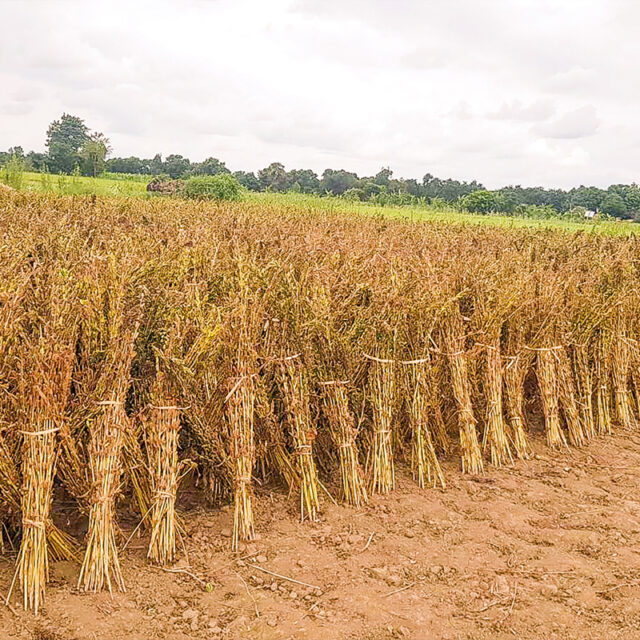By San Sandi Zaw
When we mention deforestation, it will be necessary to consider the importance of forests. A forest is usually an area filled with trees but any tall densely packed area of vegetation may be considered a forest. Forest can:
1. Produce oxygen and absorb carbon dioxide.
2. Moderate temperature and rainfall.
3. Provide food, medicine, shelter and warmth.
Deforestation is clearing the earth’s forests on a massive scale, often resulting in damage to the quality of the land and related ecosystems, and then the land is thereafter converted to non-forest use. Major causes of deforestation are (1) Agriculture Activities and Overpopulation, (2) Logging, (3) Mining, and (4) Forest Fire.
Agriculture Activities and Overpopulation
Agriculture is one of the factors causing deforestation on the planet. Due to the huge demand for food products, huge amounts of trees have fallen to grow crops and for overgrazing. Moreover, overpopulation too directly affects forest coverage. As the population grows, there is excessive exploitation of wood, bamboo, firewood, fuel and various raw materials. With the expansion of the cities, more land is also needed to establish housing and settlements.
Logging
Logging also causes deforestation. Wood-based industries like paper, match sticks, furniture etc. need a substantial amount of wood supply for our growing population. Illegal logging is now being strictly implemented and most businesses are moving into a paper-free environment. The government regulates their respective laws for the production and trade of timber products. However, these laws are being violated by taking wood illegally from the protected areas. It threatens some of the world’s most famous and valuable forests.
Mining
A lot of forested areas are rich in minerals and are vulnerable to mining operations. An analysis by the World Bank conveys that over 40 per cent of all operational mines lie in forests. Mines cause the loss of many hectares of forests. Oil and coal mining requires a considerable amount of forest land. Apart from this, roads and highways have to be built to make way for trucks and other equipment. The waste that comes out from mining pollutes the environment and affects the nearby species.
Forest Fires
Another example would be the forest blazes; hundreds of trees are lost every year due to forest fires in various portions of the world. This happens due to extremely warm summers and milder winters. Fire whether caused by man or nature results in a huge loss of forest cover. A study conducted by the Forest Survey of India indicates that, on average, fire destroys about 0.5 million hectare of forests annually.
There are many impacts on living organisms including a variety of biodiversity and environment due to deforestation. Major impacts are:
Soil Erosion and Disruption of the Water Cycle
Deforestation generally increases rates of soil loss by reducing the protection of soil from the collision of heavy raindrops. The agricultural plants replacing the forests are unable to hold onto the soil.
Trees also play a key role in the water cycle by helping to keep a balance between the water on land and water in the atmosphere. But when deforestation occurs, that balance can be upset, resulting in changes in precipitation and river flow. Trees extract groundwater through their roots and release it into the atmosphere. When part of a forest is removed, the trees no longer transpire this water, resulting in a much drier climate. Tropical rainforests produce about 30% of our planet’s fresh water.
Global Warming
Deforestation also causes the greenhouse effect that leads to global warming, a contributor to climate change. It also upsets the balance of oxygen and carbon dioxide, leading to lower oxygen levels and higher levels of pollution. These greenhouse gas emissions contribute to rising temperatures, changes in patterns of weather and an increased frequency of extreme weather. Natural forests help to mitigate carbon dioxide and other greenhouse gas emissions and prevent further global warming, purifying the air.
Biodiversity Extinction and Disruption of Livelihood
Biodiversity extinction is the most serious consequence of deforestation. Biodiversity refers to the variety of living things on Earth. It is essential for human survival and the long-term sustainability of the earth and the environment. Due to the lack of systematic conservation of biodiversity as their utilities and effects were not certainly known, many plants and animals are on the verge of extinction in many countries of the world.
Forests create nests for birds and provide homes for animals. About 80 per cent of the world’s documented species can be found in tropical rainforests. When species lose their forest homes, they are often unable to subsist in the small fragments of forested land left behind. As they become more accessible to hunters and poachers, their numbers begin to dwindle and some eventually go extinct. Even localized deforestation can cause extinctions as many unique species exist in small isolated geographic locations in the world. Forest fires, capturing and killing animals indiscriminately, reckless use of pesticides, climate change, and factors such as air, water and soil pollution also destroy biological species. When biodiversity disappears, the chain of harmony and balance between humans and the environment may be destroyed.
Similarly, when the forests are being destroyed, many species of plants and animals are also being lost, which inevitably affects the livelihood of humans. Some indigenous people’s survival is threatened by the loss of forests. Fewer trees result in an insecure future for forest workers.
How to protect the forest
The government has the resources to allow anti-deforestation organizations. This is a good way to effectively solve deforestation. The government needs to make forest management and strict rules for deforestation and illegal logging. Besides, small parks should also be promoted in the cities and the cutting down of trees should be countered by replacing them with young ones.
In order to prevent deforestation caused by human activities, public participation is also important. Individuals can practice the 3 R’S; Reduce, Reuse and Recycle items to lower the need for raw materials from trees to help preserve natural forests. We can also support non-profit organizations by donating some amount of money to the organizations to help them fight against deforestation.
There is an easy way to remember the most important points in forest preservation called TREES which means:
– Tell others about the importance of the forest and how they can help lessen deforestation/ save the environment
– Restore damaged ecosystems by planting trees on land where trees have been cut down
– Encourage people to live in a way that does not hurt the environment
– Establish parks to protect rainforests and wildlife
– Support companies that operate in ways that minimize damage to the environment.
Conservation of forests has become an important issue for the long-term benefit of the living world. Nowadays, many countries around the world are paying special attention to the conservation of trees and forests. The cultivation of forests is carried out at a rapid pace, realizing that humans play a major role in managing forests for the future of mankind. Sanctuaries, belt forests and large botanical gardens have been built at great expense with the development of technology.
The earth, weather, water, land, air, forests, trees, animals and human beings are connected with each other. Forests provide not only the existence of biodiversity but also a variety of useful materials such as rubber, rattan and small-scale agriculture for people. Half of the medicines used in the world are obtained from plants and animals.
Forests are also invaluable heritage for the greenery around the land and the key to the long-term persistence of the environment and living things. Overall, it is the responsibility of all human beings to preserve and protect the forests, and the lungs of the earth, being aware of the importance of environmental conservation and the benefits of biodiversity; the flora, fauna and a variety of living organisms.
Reference: Environmental Management Course












